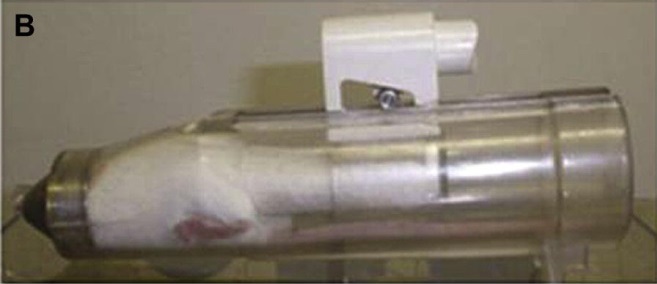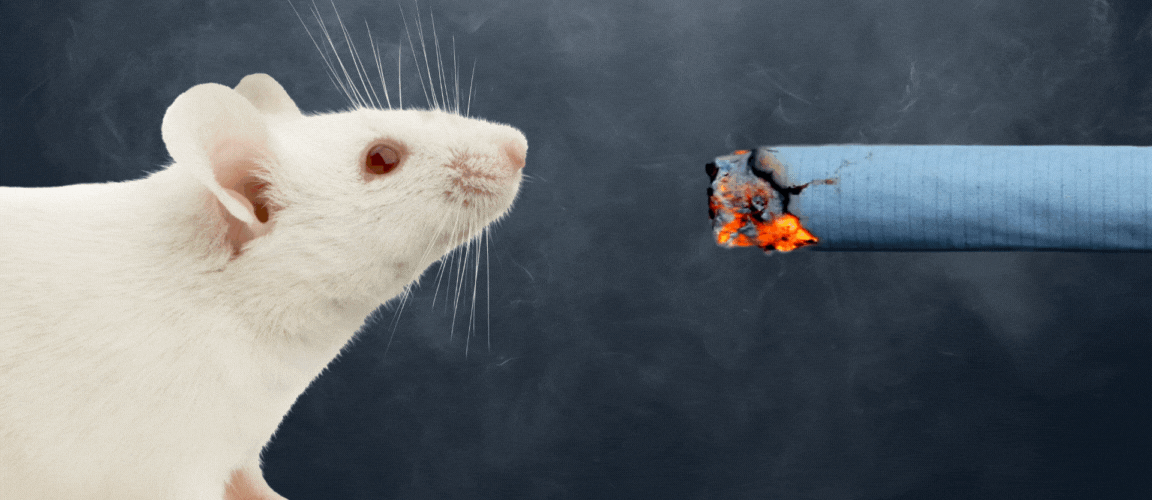UPDATE: The University of Newcastle no longer uses the nose-only smoke inhalation research method. The suggested action is no longer required.
Chronic cigarette smoke exposure induces systemic hypoxia that drives intestinal dysfunction (2018), JCI Insight Fricker, M., Goggins, B.J., Mateer, S., Jones, B., Kim,R.Y., Gellatly, S.L., Jarnicki, A.G., Powell,N., Oliver,B.G., Radford-Smith,G., Talley,N.J., Walker, M.M., Keely, S., and Hansbro,P.M. doi: 10.1172/jci.insight.94040.
Associated Institutions
University of Newcastle, Hunter Medical Research Institute, Newcastle, Guy’s and St.
Thomas’ and King’s College London, Woolcock Institute of Medical Research, The University of Sydney, University of Technology, Sydney, Royal Brisbane and Women’s
Hospital, Brisbane, University of Queensland, and QIMR Berghofer Medical Research Institute, Brisbane.
Funding
This research, according to the publication, was funded by the National Health and Medical Research Council, University of Newcastle and the Cancer Institute NSW.
The Experiment
Cigarette smoke exposure and chronic obstructive pulmonary disease (COPD) are known to be risk factors of Crohn’s Disease which is an inflammatory disease of the gastrointestinal tract.
In an attempt to recreate and understand the mechanisms of susceptibility to Crohn’s Disease (CD) associated with cigarette smoking and COPD, the researchers used a mouse model.
To develop this animal model, female mice were exposed to the smoke of 12 cigarettes twice a day, 5 times a week, for 12 weeks whilst restrained in an inhalation chamber similar to the one shown here.

Custom-designed and purpose-built directed flow inhalation and smoke-exposure system. A mouse in one of the smoking chambers. Photo for educational purposes.
Photo credit: Copyright © Elsevier. Emma L. Beckett et al (2013)
A new short-term mouse model of chronic obstructive pulmonary disease identifies a role for mast cell tryptase in pathogenesis, Journal of Allergy and Clinical Immunology, Volume 131, Issue 3,
https://doi.org/10.1016/j.jaci.2012.11.053.
(https://www.sciencedirect.com/science/article/pii/S0091674912026425)
The Code of Practice for Housing and Care of Laboratory Mice, Rats, Guinea Pigs and Rabbits states: “Animals must be able to perform a variety of natural activities consistent with species specific behaviour, including the opportunity for sufficient exercise within their enclosure“. It also states: “The provision of environmental enrichment for mice and rats should mimic natural habitat and behavioural requirements including in particular tunnelling, foraging, climbing, social groupings and nesting.” Whilst the mice are held unnaturally in small cylinders for considerable periods of time it is impossible for them to perform natural activities and behavior.
Having already suffered through induced smoking, some mice then underwent chemical damage to their intestines (using the chemical trinitrobenzenesulfonic acid (TNBS) which causes painful Crohn’s-like symptoms including bloody diarrhea.
At the end of the study the mice were anaesthetised, underwent a tracheostomy (an incision on the neck). A cannula was inserted into the trachea to inflate the lungs with a tracer gas mixture then after 9 seconds the gas was withdrawn from the lungs. The mice were then killed for further analysis.
Induction by chemical damage is the cheapest way to induce these symptoms in mice causing colitis (inflammation of the lining of the colon). The condition of colitis causes great pain and distress in both humans and in mice. Disturbingly it does not appear that any analgesics were employed in these studies to relieve the animals of their suffering although the researchers noted that the colitis lead to a “severe pathology”. The publication states that cigarette exposed-mice only were challenged with TNBS as the researchers noted “it is likely that mice with experimental COPD would not survive a TNBS challenge”.
The researchers acknowledge that the cause of CD is “incompletely understood”, and that genetic, environmental and disease risk factors play an important role in CD, yet add a different species into the mix – only serving to complicate the etiology of CD.
These extremely harsh experiments were carried out despite there being patients with the disease. In fact only a very small number of Crohn’s Disease patients were recruited from the Royal Brisbane and Womens Hospital with little reference in the publication to the results of these human studies.
Why these experiments must stop
- We already know that tobacco smoke contains more than 4500 chemicals, many of which are toxic.
- We already know that cigarette smoke is a risk factor for Crohn’s disease.
- We know that factors such as ethnic background, genetic, environmental impact on the effect of CD in humans (with mice only adding to this complication due to being a completely different species)
- Animal smoke models have limitations with every research group/institute using its own protocol for exposure and duration and varying amounts of toxic compounds used.
- The mice undoubtedly suffered stress from the smoke inhalation chambers and suffered pain and distress from chemically-induced colitis.
- This is unacceptable and inhumane and no ethics committee should allow it.
- An artificially recreated disease in a once healthy animal does not make for a reliable model for the human condition – It is simply bad science.
Non-animal COPD research using COPD patients can be read here.
Animal Ethics
Since 2008 these unacceptable and unethical experiments have been approved by the University of Newcastle Animal Ethics Committee.
Please use the form below to tell the Animal Care and Ethics Committee at the University of Newcastle, how shocked you are that they approve such inhumane experiments. You can use the text provided or compose your own.
Your message will be sent via email to Mr Alan Hales, Manager, Research Integrity Unit .
"*" indicates required fields
Please also write or email the Acting Deputy Vice-Chancellor & Vice President (Research and Innovation), University of Newcastle, requesting that the university no longer approves such animal research, in particular the flawed model of smoking experiments on mice:
Prof Elizabeth Sullivan
Acting Deputy Vice-Chancellor & Vice President (Research and Innovation)
University of Newcastle
University Drive
Callaghan NSW 2308 Email DVCRI@newcastle.edu.au
Public Statement by University of Newcastle
Following media coverage of our recent case study, University of Newcastle issued a public statement in an attempt to justify their use of mice in smoke inhalation experiments. The following is HRA’s response to that statement.
University of Newcastle: “We understand that the use of animals in research into human health and conditions is challenging for members of our society.”
HRA response: Of course it is challenging because it is cruel and inhumane, and increasingly, members of our society – including scientists – are acknowledging that animal experiments are NOT predictive of human outcomes. There are many differences between mice and humans, including intricate yet crucial differences in genetics, molecular structure, metabolism etc. Humans are not 70kg versions of mice!
University of Newcastle: “The University is firmly committed to the ethical treatment of animals involved in research and ensures that research involving animals has merit and is conducted with high standards of scientific integrity. Our Animal Ethics Committee is made up of community members, animal welfare representatives, veterinary scientists and academics.”
HRA response: Such integrity must be brought into question if it involves subjecting animals to noxious substances, whilst restraining them in smoking chambers until they succumb to altered lung function. It is not ethical to then subject them to the chemical damage to their intestines by injecting them with trinitrobenzenesulfonic acid (TNBS) causing painful colitis with symptoms that would include pain, bleeding and diarrhea.
How can this be considered ethical treatment when it allows them to suffer these painful and stressful conditions without providing analgesics?
Animal Ethics Committees are institutionalised and self-regulated. They do NOT guarantee that the research is justified. We wonder, did the Category C members of the committee (those representing the animals’ welfare) have any objections to the research going ahead and/or were they outvoted?
University of Newcastle: “Research approved by the University’s Animal Ethics Committee is reviewed under rigorous ethics guidelines to protect the welfare of animals by ensuring that their use in research is always humane, considerate, responsible and justified.”
HRA response: The procedures these mice were subjected to are clearly not humane, and certainly unjustified considering they are a totally different species. If the University’s Animal Ethics Committee (AEC) is satisfied with its decision to allow these procedures to be undertaken, the AEC should provide their deliberations to members of the public, and at the very least, answer correspondence directed to them by concerned members of the public.
University of Newcastle: “Where animal models are used, they present an opportunity to research human illnesses in an environment that simulates human biological function and minimises misleading results given using non-animal methods. The similarity of the reproductive and nervous systems between mice and humans means that human disease in these biological systems can be better understood.”
HRA response: The best case scenario is that the illness is SIMULATED. It does not take into consideration the many environmental factors experienced by human patients.
We strongly argue that non-animal methods can provide reliable human–relevant results and it is the animal models that provide the misleading results. Take for example the numerous documented examples of animal research delaying progress such as penicillin, blood transfusions and development of the Polio vaccine – all delayed due to reliance of data from animal experiments.
We also point out that animal smoke models have limitations with every research group/institute using its own protocol for exposure and duration and varying amounts of toxic compounds used.
University of Newcastle: “The University remains committed to our goal of undertaking ground-breaking research that makes a difference to public health and wellbeing.”
HRA response: What alternatives were considered by the ethics committee? Had they been in contact with researchers from Emulate Inc in the United States which is developing lung on a chip and other advanced technologies such as the robotic smoking machine? Is the university investing in methodologies which do not involve animals and instead focusing on human-relevant outcomes?
Humane Research Australia remains highly critical of ongoing experiments that continue to expose animals to incredible suffering for little or no benefit to humans. We hold that an artificially recreated disease in a once healthy animal does not make for a reliable model for the humane condition.
For further information about the use of mice and rats in research, see Rats and Mice – Maligned and Misunderstood.
